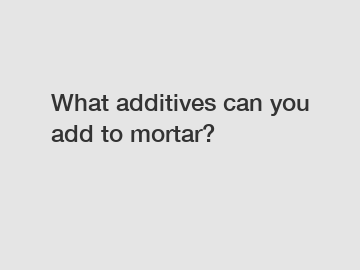What additives can you add to mortar?
What additives can you add to mortar?
Mortar is a crucial component in construction projects, acting as a binding agent for bricks, stones, or concrete blocks. It is primarily composed of cement, sand, and water. However, additives can be incorporated into the mortar mix to enhance its properties, improve workability, and increase its overall performance. In this article, we will explore various additives that can be added to mortar and their benefits.
1. Plasticizers.

Plasticizers, also known as water-reducing admixtures, are commonly used additives in mortar. They help to increase workability and reduce water content, leading to stronger and more durable mortar. By reducing the amount of water required, plasticizers improve the density and decrease the permeability of the mortar, minimizing the risk of water penetration and subsequent damage.
2. Air-Entraining Agents.
In regions with freezing and thawing cycles, the addition of air-entraining agents to mortar is essential. These additives create tiny air bubbles in the mixture, enhancing its resistance to freeze-thaw cycles. When water freezes, it expands, posing a significant threat to the structural integrity of the mortar. Air-entraining agents improve mortar's ability to withstand such cycles, reducing the likelihood of cracking or crumbling.
3. Accelerators.
Sometimes construction projects demand expedited setting times. This is where accelerators come into play. By adding accelerators to mortar, the setting time can be significantly reduced. This allows construction workers to expedite the building process, ensuring timely project completion. However, it is important to note that too much accelerator can increase the risk of shrinkage and cracking, so a balanced approach is crucial.
4. Retarders.
On the other end of the spectrum, there are cases where extending the setting time of mortar is necessary. Retarders are additives that delay the mortar's setting process, providing extra time for workers to adjust and make necessary modifications before it becomes too rigid. These additives are particularly useful in hot weather conditions or when dealing with large-scale projects, where delays could cause issues.
5. Bonding Agents.
When repairing or renovating existing structures, bonding agents are often used. These additives improve the bond strength between new and old mortar, ensuring a seamless and secure connection. Bonding agents are especially crucial when working with surfaces that have poor adhesion characteristics, such as smooth or painted surfaces. They promote adhesion, minimize the risk of delamination, and enhance the overall structural integrity of the repaired area.
6. Pigments.
While the primary function of mortar is to hold building materials together, it can also be used aesthetically. Pigments can be added to mortar to achieve different colors, allowing for creative and decorative designs. This is particularly popular in architectural projects where the mortar acts as a visible element, contributing to the overall appearance of the structure.
In conclusion, mortar additives play a significant role in enhancing the performance, workability, and aesthetics of mortar. Plasticizers improve workability and strength, air-entraining agents protect against freeze-thaw cycles, accelerators expedite setting times, and retarders provide additional working time. Bonding agents ensure a strong bond when repairing or renovating structures, and pigments offer versatility in design. Understanding the benefits and limitations of each additive is crucial for ensuring successful construction projects. So, the next time you embark on a construction endeavor involving mortar, consider incorporating these additives to optimize the performance and visual appeal of your mortar.
For more information, please visit gypsum retarders, hpmc manufacturer, gypsum retarders.
259
0
0

Comments
All Comments (0)